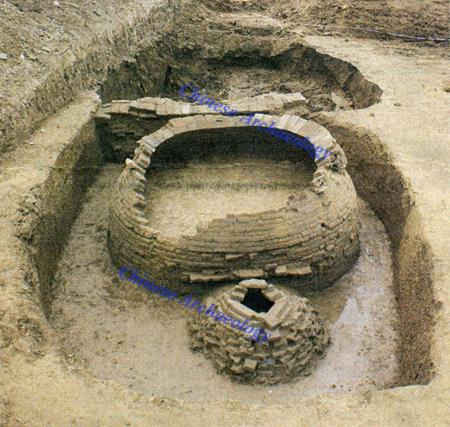Chinese Institute of Archaeology
Source - http://www.kaogu.cn/en/News/New_discoveries/2015/0810/51087.html
On March 24, 2015, in Duoshi town, Jiyang county, Shandong province, two tombs from Tang dynasty were found. According to the unearthed cultural relics and the distribution of the tombs, these two tombs were from the same family, the family of Gu Cun, the magistrate of Linji county (which was called Jiyang today) in Tang dynasty.
 Tomb No.1
Tomb No.1
 Tomb No.2
Tomb No.2
Tomb No.1 was located 5 meters northwest of Tomb No.2, which was a single brick-chambered tomb with dome top, consisted of tomb passage, paved path and round chamber. The diameter of the chamber is 3.1 meters, unearthing one red pottery jar, one white-glazed ceramic bowl, one “Kaiyuan Tongbao” coin, iron fragments, bones of the occupant and etc. Tomb No.2 was the main tomb, the top collapsed when archaeologists found it. The tomb was also a brick-chambered tomb with dome top. It consisted of tomb passage, door, paved path, front chamber and back chamber, and it was 18 meters’ long. The door was grant, nearly 4 meters’ high and 3.5 meters’ wide. The front chamber was 5 meters in height and 4.3 meters in diameter. The top part of the outer wall was constructed in cornice (so-called official hat shaped), only part of it was preserved because of the collapse. Two pottery jars, one ceramic jar, dozens of “Kaiyuan Tongbao” coins (incomplete ones), epitaph of the magistrate were unearthed from the bottom part, but no official seal was found. The coffin platform paved with blue bricks was found at the north of the middle part of the chamber bottom. Only few white and grey, red paintings were left on the walls, being speculated it might have colored fresco before. On the upper part of either west or east side of the chamber had 6 brick carving brackets (Dougong). At the north of the east wall, there was a table and a window; under the window, a coned brick construction with colored paintings beneath was found, which had flat top with square holes, seemed like golden hill and money tree. At the north of the west wall, there was a chair and a window, both were side figures, and both had red paintings. Extended eaves were constructed between the front and back chamber. The back chamber was 1.8 meters height, about 1 meter in diameter, and it was oval-shaped with dome top. Few fragment of the coffin timber was found, and the wall arc looked elegant. No burial objects were found, being speculated it might have been stolen.
 The interior of Tomb No.1
The interior of Tomb No.1
 The epigraph of Tomb No.2
The epigraph of Tomb No.2
According to the preliminary study, it can be known that the occupant was called Gu Cun, and his courtesy name was Shuwen. He was from Wu county, born in the fourth year of the reign of Dezong of Tang dynasty (A.D. 783), died on 10th of the tenth month of the reign of Wenzong of Tang dynasty (A.D. 836). According to the historical records, Gu Cun was born in a noble family in the southern China, and was the assistant magistrate of Huang county, magistrate of Dongguang county, Zhangqiu county and Linji county successively. (Translator: Wang Jue)